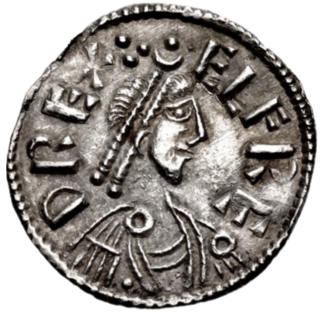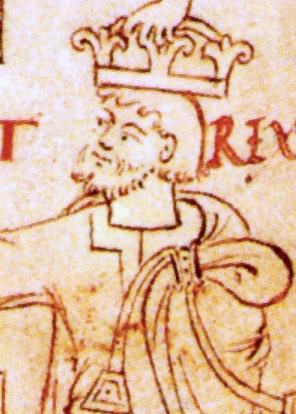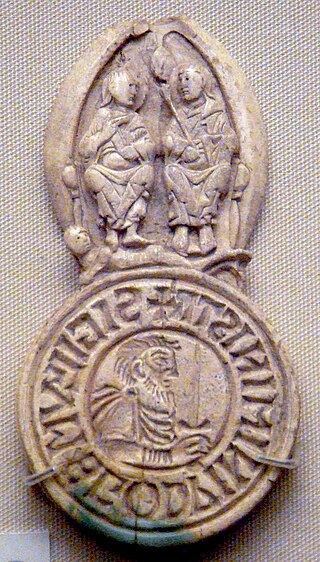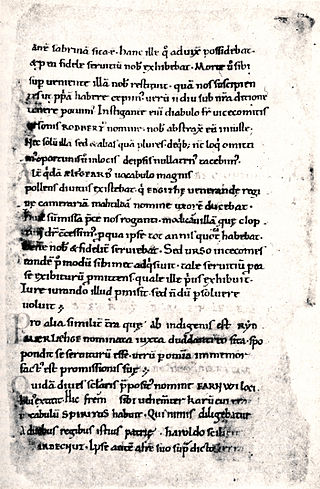Related Research Articles

Alfred the Great was King of the West Saxons from 871 to 886, and King of the Anglo-Saxons from 886 until his death in 899. He was the youngest son of King Æthelwulf and his first wife Osburh, who both died when Alfred was young. Three of Alfred's brothers, Æthelbald, Æthelberht and Æthelred, reigned in turn before him. Under Alfred's rule, considerable administrative and military reforms were introduced, prompting lasting change in England.

Æthelred II, known as Æthelred the Unready, was King of the English from 978 to 1013 and again from 1014 until his death in 1016. His epithet comes from the Old English word unræd meaning "poorly advised"; it is a pun on his name, which means "well advised".

The Anglo-Saxons, the English or Saxons of Britain, were a cultural group who spoke Old English and inhabited much of what is now England and south-eastern Scotland in the Early Middle Ages. They traced their origins to Germanic settlers who became one of the most important cultural groups in Britain by the 5th century. Historically, the Anglo-Saxon period in Britain is considered to have started by about 450 and ended in 1066, with the Norman Conquest. Although the details of their early settlement and political development are not clear, by the 8th century a single Anglo-Saxon cultural identity which was generally called Englisc, had developed out of the interaction of these settlers with the pre-existing Romano-British culture. By 1066, most of the people of what is now England spoke Old English, and were considered English. Viking and Norman invasions changed the politics and culture of England significantly, but the overarching Anglo-Saxon identity evolved and remained dominant even after the Norman Conquest of 1066. Late Anglo-Saxon political structures and language are the direct predecessors of the high medieval Kingdom of England and the Middle English language. Although the modern English language owes less than 26% of its words to Old English, this includes the vast majority of everyday words.
Godwin of Wessex was an English nobleman who became one of the most powerful earls in England under the Danish king Cnut the Great and his successors. Cnut made Godwin the first Earl of Wessex. Godwin was the father of King Harold II and of Edith of Wessex, who in 1045 married King Edward the Confessor.

Cnut, also known as Canute and with the epithet the Great, was King of England from 1016, King of Denmark from 1018, and King of Norway from 1028 until his death in 1035. The three kingdoms united under Cnut's rule are referred to together as the North Sea Empire by historians.

Copyhold was a form of customary land ownership common from the Late Middle Ages into modern times in England. The name for this type of land tenure is derived from the act of giving a copy of the relevant title deed that is recorded in the manorial court roll to the tenant; not the actual land deed itself. The legal owner of the manor land remained the mesne lord, who was legally the copyholder, according to the titles and customs written down in the manorial roll. In return for being given land, a copyhold tenant was required to carry out specific manorial duties or services. The specific rights and duties of copyhold tenants varied greatly from one manor to another and many were established by custom. By the 19th century, many customary duties had been replaced with the payment of rent.
Tostig Godwinson was an Anglo-Saxon Earl of Northumbria and brother of King Harold Godwinson. After being exiled by his brother, Tostig supported the Norwegian king Harald Hardrada's invasion of England, and was killed alongside Hardrada at the Battle of Stamford Bridge in 1066.
Ælfgifu of Northampton was the first wife of Cnut the Great, King of England and Denmark, and mother of Harold Harefoot, King of England. She was regent of Norway from 1030 to 1035.
A fyrd was a type of early Anglo-Saxon army that was mobilised from freemen or paid men to defend their Shire's lords estate, or from selected representatives to join a royal expedition. Service in the fyrd was usually of short duration and participants were expected to provide their own arms and provisions.

In later Anglo-Saxon England, a thegn or thane was an aristocrat who owned substantial land in one or more counties. Thanes ranked at the third level in lay society, below the king and ealdormen. Thanage refers to the tenure by which lands were held by a thane as well as the rank.

A housecarl was a non-servile manservant or household bodyguard in medieval Northern Europe.

Anglo-Saxon law was the legal system of Anglo-Saxon England from the 6th century until the Norman Conquest of 1066. It was a form of Germanic law based on unwritten custom known as folk-right and on written laws enacted by kings with the advice of their witan or council. By the later Anglo-Saxon period, a system of courts had developed to administer the law, while enforcement was the responsibility of ealdormen and royal officials such as sheriffs, in addition to self-policing by local communities.

In Anglo-Saxon England, a reeve was an administrative official serving the king or a lesser lord in a variety of roles. After the Norman Conquest, it was an office held by a man of lower rank, appointed as manager of a manor and overseer of the peasants. In this later role, historian H. R. Loyn observes, "he is the earliest English specialist in estate management."

Eadric Streona was Ealdorman of Mercia from 1007 until he was killed by King Cnut. Eadric was given the epithet "Streona" in Hemming's Cartulary because he appropriated church land and funds for himself. Eadric became infamous in the Middle Ages because of his traitorous actions during the Danish re-conquest of England.
Uhtred of Bamburgh, was ruler of Bamburgh and from 1006 to 1016 the ealdorman of Northumbria. He was the son of Waltheof I, ruler of Bamburgh (Bebbanburg), whose family the Eadwulfings had ruled the surrounding region for over a century. Uhtred's death by assassination was described in De obsessione Dunelmi and has been interpreted as the beginning of a blood feud. Lest he be confused with Uhtred, the son of Eadwulf I of Bamburgh, he historically has been referred to as Uhtred the Bold.

Wulfric, called Wulfric Spot or Spott, was an Anglo-Saxon nobleman. His will is an important document from the reign of King Æthelred the Unready. Wulfric was a patron of the Burton Abbey, around which the modern town of Burton on Trent later grew up, and may have refounded the Benedictine monastery there.
Geþyncðo, meaning “Dignities”, is the title given to an Old English legal tract on status and social mobility, probably written by Wulfstan (II), Archbishop of York between 1002 and 1023. It is sometimes known as one of the so-called 'promotion laws', along with Norðlleoda laga, and both these texts belong to a legal compilation on status, dubbed ‘the Geþyncðu group’ by the historian Patrick Wormald. Though the extent to which these reflect reality is a topic of some debate, they constitute one of the most valuable primary documents for an understanding of social status in late Anglo-Saxon England.
Thurbrand, nicknamed "the Hold", was a Northumbrian magnate in the early 11th century. Perhaps based in Holderness and East Yorkshire, Thurbrand was recorded as the killer of Uhtred the Bold, Earl of Northumbria. The killing appears to have been part of the war between Sweyn Forkbeard and Cnut the Great against the English king Æthelred the Unready, Uhtred being the latter's chief Northumbrian supporter. Thurbrand may also have attested a charter of 1009 and given a horse to Æthelred's son Æthelstan Ætheling. The killing is the first-known act, if it did not initiate, a bloodfeud between Thurbrand's family and Uhtred going into the time of Earl Waltheof. It is possible that Holderness took its name because of Thurbrand's presence or ownership of the peninsula.

Feudalism as practiced in the Kingdoms of England during the medieval period was a state of human society that organized political and military leadership and force around a stratified formal structure based on land tenure. As a military defence and socio-economic paradigm designed to direct the wealth of the land to the king while it levied military troops to his causes, feudal society was ordered around relationships derived from the holding of land. Such landholdings are termed fiefdoms, traders, fiefs, or fees.

Edmund Ætheling was a son of Edmund Ironside and his wife Ealdgyth. Edmund Ironside briefly ruled as king of England following the death of his father Æthelred the Unready in April 1016. Æthelred had spent most of his reign unsuccessfully resisting incursions by Danish Vikings, and as king Edmund Ironside put up a strong fight until his death in November 1016, when the Viking leader Cnut became the undisputed king of all England.
References
- 1 2 Chisholm 1911.
- ↑ Brooks 1978, pp. 91–92.
- ↑ Pracy 2024, pp. 88–92.
- ↑ Friar, Stephen (2001). The Sutton Companion to Local History (rev. ed.). Stroud: Sutton Publishing. p. 209. ISBN 0-7509-2723-2.